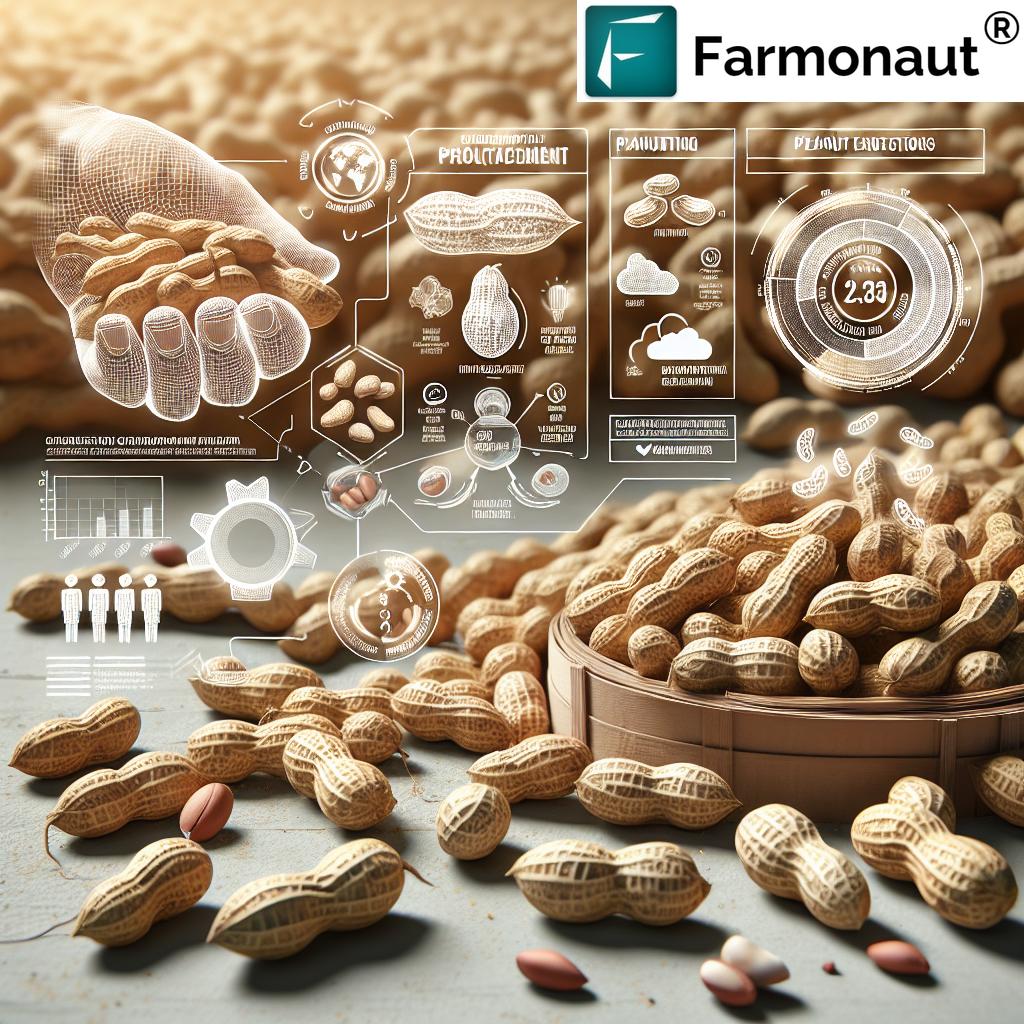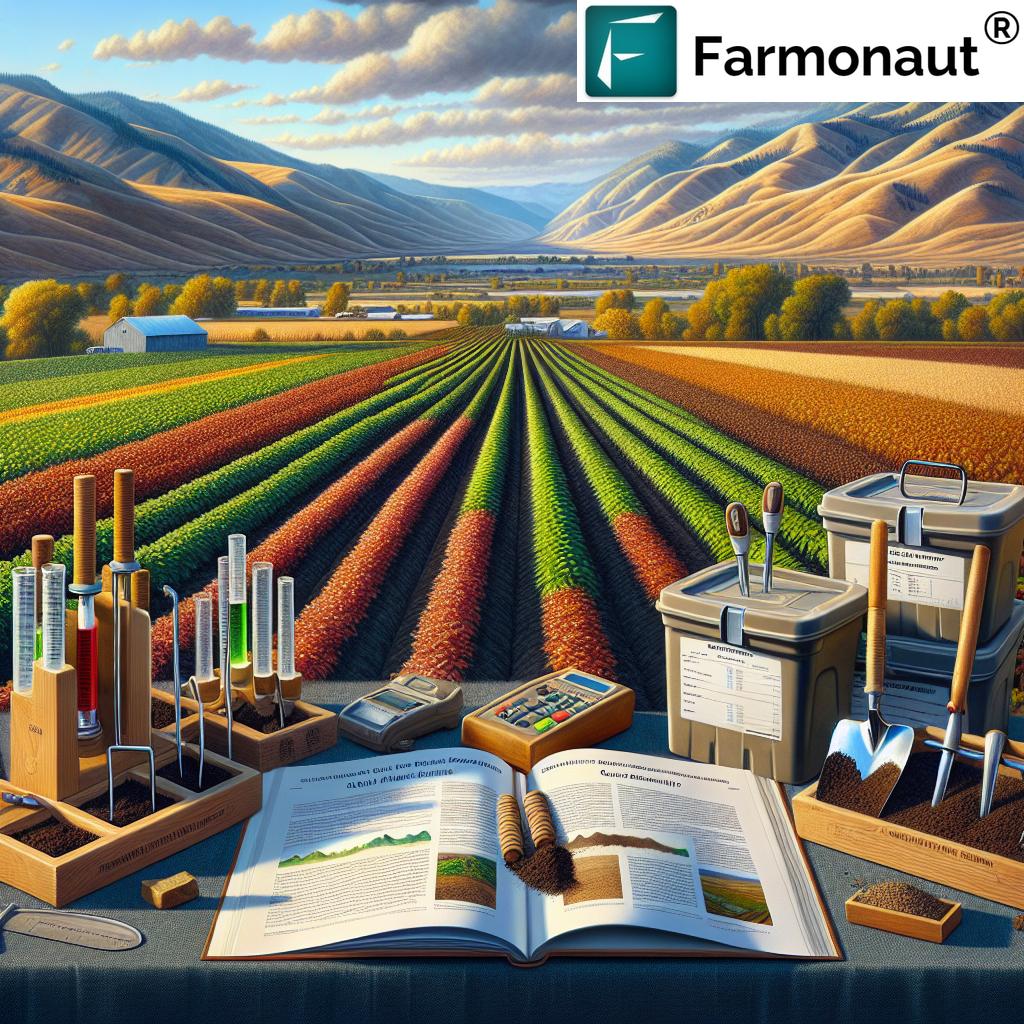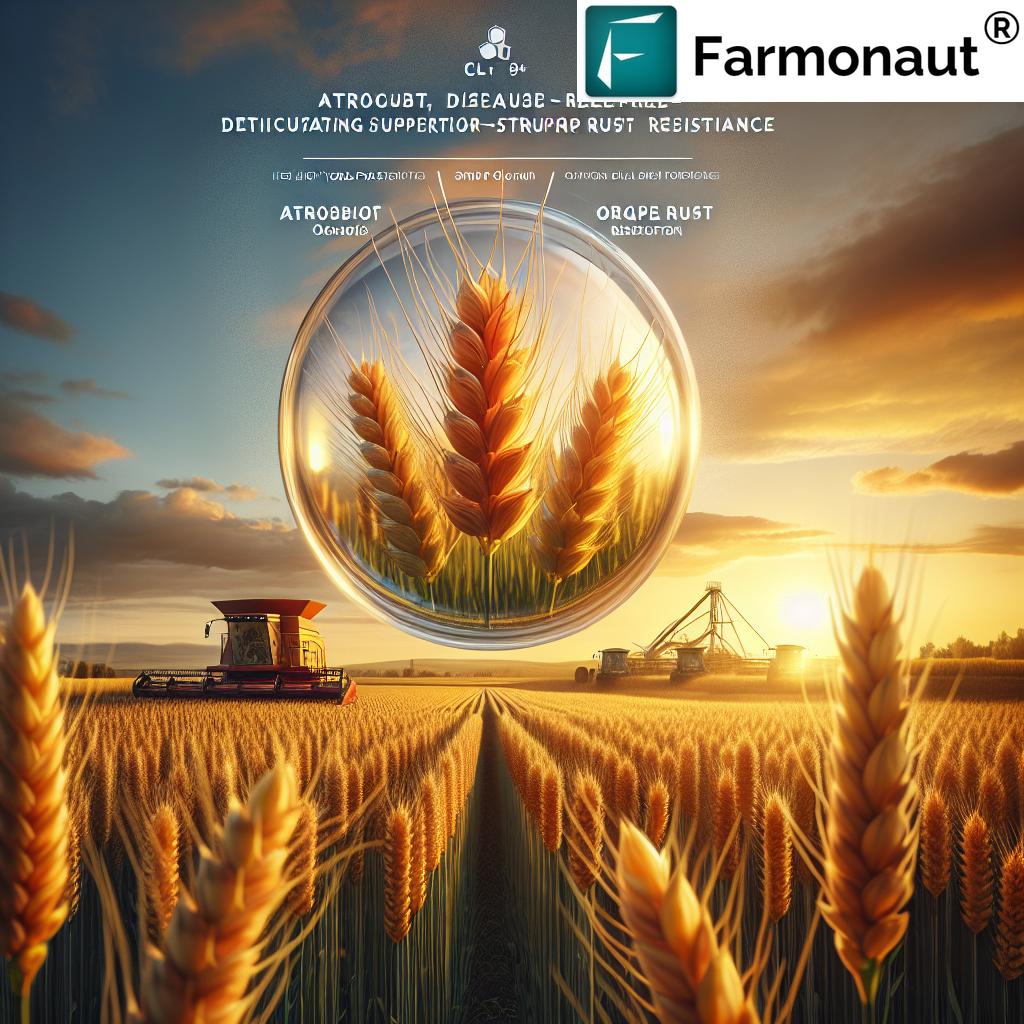Peanut Growing Hacks: 7 U.S. Farmers’ Secret Practices!
Table of Contents
- Introduction
- Peanut Cultivation Essentials: History and Global Production
- 7 U.S. Farmers’ Secret Peanut Growing Practices
- 1. Mastering Peanut Variety Selection
- 2. Soil Secrets: Choosing and Preparing the Best Soil for Peanuts
- 3. Sustainable Crop Rotation for Disease and Pest Management
- 4. Precision Planting and Spacing for Maximum Yield
- 5. Smart Irrigation – Meeting Peanut Water Requirements
- 6. Sustainable Fertilization & Nitrogen Management
- 7. Harvest Timing, Curing, and Storage Mastery
- Comparison Table: Sustainable Peanut Farming Practices Across U.S. Regions
- Sustainability and Peanut Farming: Environmental Perspective
- Farmonaut’s Advanced Peanut Farming Solutions
- Global Peanut Production Statistics and U.S. Role
- Frequently Asked Questions
- Conclusion
“U.S. farmers using crop rotation can boost peanut yields by up to 25% while reducing soil-borne diseases.”
Introduction: Why Peanut Cultivation Matters
Peanut cultivation stands as a vital component of global agriculture, contributing significantly to food security, nutrition, and rural economies. In the United States, as in other peanut-producing regions around the world, peanuts (Arachis hypogaea) are more than just a snack—they are an agricultural powerhouse.
Despite their name, peanuts are botanically classified as legumes, offering remarkable health benefits and serving as a sustainable source of dietary protein, oils, and essential nutrients. As we navigate the evolving challenges in agriculture—climate unpredictability, resource limitations, and demands for sustainability—mastering peanuts’ unique requirements is crucial. Our guide reveals proven hacks, grounded in expert U.S. peanut farming practices, focused on sustainability, disease management, best soil for peanuts, water usage, and digital innovation.
Peanut Cultivation Essentials: History and Global Production
Historical Roots and Spread of Peanut Cultivation
Peanuts have an illustrious history stretching thousands of years, first cultivated in South America. Through exploration and trade, they spread to Africa and Asia, adapting to new climates and becoming an indispensable part of many diets and cultures.
In the United States, the 19th and 20th centuries marked a turning point for peanuts, especially thanks to George Washington Carver. His advocacy for sustainable rotations with peanuts and innovations in peanut product development transformed U.S. agriculture and economic reliance on this crop.
Global Peanut Production Statistics
- China leads global peanut production, with over 18.3 million metric tons annually (statista.com).
- India holds second place, producing just over 10 million metric tons.
- The United States consistently ranks among the top three producers, especially in states like Georgia, Alabama, and Texas.
These figures underscore peanuts’ global importance—as a key nutrition and economic source for millions.
Peanut Farming Practices: 7 U.S. Farmers’ Secret Hacks for Sustainable and Profitable Yields
1. Mastering Peanut Variety Selection
The foundation of successful peanut cultivation lies in choosing the right variety. Different peanut varieties thrive in different U.S. climates and soils, and offer distinct benefits:
- Virginia Peanuts: Large-seeded variety, suited for roasting and in-shell snacks. Adapted to Virginia, North Carolina, South Carolina, and parts of Texas.
- Spanish Peanuts: Smaller kernel with red skins, higher oil content—a favorite for candy production. Popular in Oklahoma and Texas.
- Valencia Peanuts: Sweet flavor, several small kernels within each shell, often used for fresh eating and organic markets. Best for New Mexico and West Texas.
- Runner Peanuts: Medium-sized, with uniform kernels; dominate peanut butter production in states like Georgia and Alabama.
When selecting peanut varieties, we should consider:
- Climate of our location (length of growing season, frost risk, heat)
- Soil characteristics (loam texture, drainage, pH)
- Disease resistance required (e.g., TSWV-resistant lines)
- End use (snack, oil, peanut butter, fresh market)
2. Soil Secrets: Choosing and Preparing the Best Soil for Peanuts
Our peanut crop will only be as healthy as the soil it grows in. Sandy loam soils are consistently cited as the best soil for peanuts due to their optimal drainage and easy formation of peanut pods underground. Here’s what we need for peanut soil success:
- Texture: Sandy loam with good structure encourages root expansion and prevents waterlogging.
- Drainage: Peanuts are highly sensitive to waterlogging. A well-drained profile is critical to avoid pod rot and fungal disease.
- Soil pH: Maintain a pH of 5.8–6.2. Use lime to adjust pH upwards if needed.
- Organic Matter: Including composts or cover crops improves soil health and supports microbial activity.
- Preparation: Deep-till or use strip-tillage to alleviate compaction, reduce erosion, and create a soft bed for seed placing.
Soil tests before every planting season guide our fertilization plan, ensuring balanced nutrients, especially calcium for strong pod development.
3. Sustainable Crop Rotation for Disease and Pest Management
One of the most effective long-term peanut farming practices is crop rotation. Rotating peanuts with non-host crops—such as corn, sorghum, or cotton—not only disrupts the life cycles of peanut diseases and pests, but also prevents depletion of specific soil nutrients.
- Disease Management: Crop rotation helps suppress threats like white mold and leaf spot, and nearly eliminates nematode buildup in the soil.
- Weed Control: Varying crops allows for different weed control strategies, curbing herbicide-resistant weeds.
- Soil Fertility: Grass crops in the rotation conserve nitrogen and improve soil organic matter.
- Cycle Recommendation: The widely recommended approach is a three-to-four-year rotation: peanuts return to the same field only every third or fourth year.
This not only yields a peanut crop rotation benefit of up to 25% higher yields (see trivia!), but also reduces disease severity and protects soil structure.
“Sustainable peanut farming practices can cut water usage by nearly 40% compared to conventional methods.”
4. Precision Planting and Spacing for Maximum Peanut Yield
Optimal planting and precise seed spacing are central to healthy peanut cultivation. Crowded fields breed disease by reducing airflow, while overly spaced rows limit yield potential. We follow these guidelines for strong stands:
- Timing: Plant in early spring, as soon as the soil reaches 65°F (18°C).
- Depth: Sow seeds 1 to 2 inches deep.
- In-Row Spacing: 6–8 inches between seeds allows strong root and peg development.
- Row Spacing: 24–36 inches between rows ensures each plant receives light and airflow.
- Equipment: Use calibrated planters for uniform sowing, or monitor seeding density with technology solutions for higher consistency.
Precision planting not only boosts yields but also enhances disease management by discouraging fungal spread.
5. Smart Irrigation – Meeting Peanut Water Requirements
Peanut irrigation requirements can make or break a crop. Peanuts are relatively drought-tolerant but require consistent moisture during critical stages—especially flowering and during pod fill. Improper irrigation leads to poor kernel development and can encourage mold growth if overdone.
- Irrigation Method: Drip irrigation is highly recommended. It delivers water directly to the soil, reducing evaporation and keeping foliage dry—a key disease management benefit.
- Water Use: Peanuts require about 20–24 inches of rainfall or irrigation per season.
- Monitoring: Use soil moisture sensors or satellite-based soil moisture monitoring platforms.
- Schedule: Water more heavily during flowering/pod setting, and taper during the ripening phase.
- Avoid: Overwatering and standing water to prevent fungal issues and root/peg rot.
Smart irrigation can reduce overall water use by up to 40% compared to traditional methods—see trivia above!
6. Sustainable Fertilization & Nitrogen Management for Peanuts
Peanuts are legumes and, through a symbiotic relationship with nitrogen-fixing bacteria, often require less external nitrogen than other crops. Proper fertilization supports robust plant growth without promoting excessive foliage at the expense of pod formation.
- Phosphorus & Potassium: Base all applications on pre-plant soil tests. Both elements support pod development and disease resistance.
- Nitrogen: Apply sparingly or not at all unless there’s a proven deficiency.
- Calcium: Essential during pegging—apply gypsum if required based on soil tests.
- Micronutrients: Monitor zinc, boron, and manganese for best results.
- Timing: Incorporate fertilizers into the soil prior to planting or use precision side-dress banding.
Over-fertilizing, especially with nitrogen, can hinder yield rather than help. Sustainable fertilization approaches are both cost-effective and support peanut sustainability.
7. Harvest Timing, Curing, and Storage Mastery
Optimal peanut harvesting and storage is crucial to protect yield and health benefits of kernels. If harvested too early, peanuts have low oil content; too late, and the risk of field loss and aflatoxin mold rises.
- Signs of Maturity: Yellowing foliage and darkening of the inside hulls indicate ready-for-harvest peanuts—typically after 120–150 days.
- Harvesting: Use diggers/inverters to unearth the crop, then allow direct sun drying for a brief period, followed by proper curing.
- Curing: Air-dry in well-ventilated sheds for 7–10 days.
- Storage: Maintain a moisture content below 10% and store in cool, dry conditions to control mold and insect activity.
- Equipment: Utilize moisture meters and clean, aerated storage facilities.
Sound storage protocols secure both market value and nutrition for long-term sales or value-added processing.
Comparison Table: Sustainable Peanut Farming Practices Across U.S. Regions
To help us quickly compare regional sustainability strategies that lead to productive peanut harvests, here’s a concise reference table. Each practice reflects wide U.S. usage and demonstrates yield improvement, soil health, and environmental advantages.
| Farming Practice | Estimated Yield Improvement (%) | Soil Benefit | Environmental Impact | Regional Uptake (%) |
|---|---|---|---|---|
| Crop Rotation (3-4 year) | 20–25 | Reduced disease pressure, improved soil fertility | Lower pesticide use, reduced soil erosion | 75 |
| Cover Cropping | 8–12 | Increased organic matter | Enhanced biodiversity | 50 |
| Strip/Reduced Tillage | 6–10 | Improved soil structure, less compaction | Reduced emissions, lower fuel use | 45 |
| Precision Drip Irrigation | 10–18 | Prevents waterlogging | Reduced water usage (up to 40%) | 35 |
| Integrated Pest Management (IPM) | 7–15 | Reduction in chemical residues | Minimized non-target impacts | 60 |
Sustainability and Peanut Farming: Environmental Perspective
Sustainability is at the heart of modern peanut cultivation in the United States and beyond. Peanuts offer unique environmental benefits:
- Nitrogen Fixation: As legumes, peanuts fix nitrogen from the air, naturally enriching the soil and reducing fertilizer dependence. This minimizes input costs and helps maintain crop rotations that build soil health.
- Water Efficiency: Peanuts are water-wise. Producing one ounce of shelled peanuts requires only 3.2 gallons of water, compared to 28.7 gallons for almonds (gapeanuts.com).
- Soil Conservation: Reduced-, no-, and strip-tillage methods decrease erosion and conserve precious topsoil. These techniques are especially useful in sandy, erosion-prone peanut growing regions.
- Carbon Footprint Reduction: Advanced resource monitoring, such as carbon footprint calculation, helps farms track and decrease their environmental impact. Farmonaut provides carbon footprint tracking, empowering growers to target sustainable production goals.
These sustainability practices set peanut farming apart as a leading example of resource-smart, environmentally responsible agriculture.
Farmonaut’s Advanced Solutions for Peanut Crop Success
Modern peanut farming thrives on data-driven decisions. Farmonaut—a leader in agricultural technology—revolutionizes peanut production through satellite imagery, artificial intelligence, and blockchain for traceability. Here’s how our tools can elevate U.S. and global peanut farms:
- Real-Time Crop Monitoring: Monitor peanut crop health, vegetation vigor (NDVI), and soil moisture via satellite from any device. This empowers us to spot stress before it impacts yield and make timely irrigation or nutrient adjustments.
- AI-Powered Advisory: The Jeevn AI Advisory System analyzes field data to deliver customized, real-time advice according to weather and crop stage.
- Efficient Resource Management: Track and optimize machinery, labor, and fleet operations with fleet management solutions—lowering costs and improving operational safety on large-acreage peanut farms.
- Blockchain Traceability: Our blockchain-based traceability platform ensures peanut products move transparently from field to store shelf, building consumer trust and supporting U.S. food standards.
- Carbon Footprinting: Monitor emissions and environmental impact in real-time. Set sustainability goals using Farmonaut’s carbon footprinting tools for peanut and rotational crops.
- Risk Mitigation & Financing: Banks and insurers can access satellite-based farm verification to reduce fraud and speed up crop loan and insurance approvals for peanut operations.
-
Scalable, Flexible Access: Farmonaut’s services are available via mobile app, browser, and API integration, making cutting-edge tech accessible to all farm sizes. Explore our
API developer docs.
Whether you’re managing thousands of acres or a small family operation, Farmonaut’s data-driven services not only reduce resource wastage, but also advance sustainable peanut production and market competitiveness.
Ready to experience Farmonaut? Get started on our large-scale farm management app for a complete overview of peanut, cotton, maize, and other rotations, or access our full user dashboard via web, iOS, or Android!
Global Peanut Production Statistics and the U.S. Role
As peanut producers, we benefit from a deep understanding of global market dynamics and competition:
- China: The world’s top peanut grower—over 18.3 million metric tons per year.
- India: Over 10 million metric tons and a headquarters for diverse, rainfed peanut farming.
- United States: Around 2–3 million metric tons annually. Georgia, Alabama, and Texas drive the U.S. industry, exporting high-quality peanuts globally, especially for snack and confectionery uses.
The economic significance of peanuts in the U.S. is immense—supporting 7,000+ farming families and an extensive value chain in food processing.
- Products & Markets: Peanut butter, roasted snacks, oils, confections, and emerging plant-based foods.
- Export Demand: The U.S. is renowned for high standards and traceable production, supported by technological solutions like those from Farmonaut.
Continuous advancements in breeding, disease management, and sustainable production will be vital for U.S. competitiveness, particularly as climate change introduces new challenges and opportunities.
Frequently Asked Questions (FAQ)
What are the best soil requirements for peanuts?
Peanuts thrive in sandy loam soils with excellent drainage and a pH of 5.8–6.2. Amending soil with organic matter and performing regular soil tests helps optimize structure and fertility.
How often should peanuts be rotated with other crops for sustainable disease management?
For maximum disease suppression and soil resilience, rotate peanuts every 3–4 years, preferably using grass crops like corn or sorghum between peanut cycles.
What is the ideal irrigation strategy for peanuts?
Drip irrigation is preferable, as it reduces disease and improves water efficiency. Peanuts require steady moisture during flowering and pod fill, about 20–24 inches of rainfall or equivalent irrigation in total.
How does Farmonaut support peanut farmers?
Farmonaut supplies real-time satellite monitoring, AI-based advisory, soil moisture tracking, blockchain traceability, and carbon footprinting tools, helping farmers boost yields, cut waste, comply with regulations, and adopt sustainable farming.
What steps should be taken post-harvest?
After lifting peanuts, cure them for 7–10 days in a well-ventilated area, dry to below 10% moisture, then store in cool, dry, pest-free facilities to prevent mold and quality loss.
Conclusion: Thriving Peanut Cultivation through Proven Hacks and Sustainability
Peanut cultivation in the United States—and globally—has progressed far beyond traditional methods. Our review of seven secret peanut growing hacks highlights how smart variety selection, careful soil management, meticulous rotation, precision irrigation, targeted fertilization, and advanced post-harvest strategies can transform yields and profitability. These hacks build not only farm income, but also sustain soil, water, and environmental resources for future generations.
Bridging tradition with Farmonaut’s technology, we access real-time, data-driven solutions to monitor crops, manage resources, ensure traceability, and lower agriculture’s environmental impact. Peanuts—Arachis hypogaea—embody both nutrition and the sustainable spirit of farming.
As we move forward, embracing sustainable peanut production will keep the United States at the forefront of global agricultural innovation. For more support, download the Farmonaut app (Web/iOS/Android), or access precision data through our API and developer documentation.
Boost your peanut farm’s success—start transforming your fields today!
















